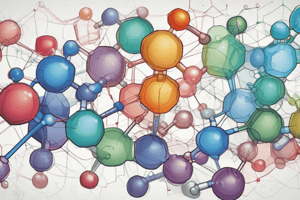Podcast
Questions and Answers
What is the primary purpose of Hantzsch-Widman nomenclature?
What is the primary purpose of Hantzsch-Widman nomenclature?
- To synthesize heterocyclic compounds
- To identify the molecular weight of a compound
- To determine the boiling point of a compound
- To provide a systematic and consistent way of naming heterocyclic compounds (correct)
What is the prefix used to indicate the presence of an oxygen atom in a heterocyclic compound?
What is the prefix used to indicate the presence of an oxygen atom in a heterocyclic compound?
- az-
- nitro-
- ox- (correct)
- th-
How is the parent compound numbered in Hantzsch-Widman nomenclature?
How is the parent compound numbered in Hantzsch-Widman nomenclature?
- Starting from the heteroatom and then around the ring in a clockwise direction (correct)
- Starting from the substituent and then around the ring in a counterclockwise direction
- Starting from the functional group and then around the ring in a clockwise direction
- Starting from the carbon atom and then around the ring in a counterclockwise direction
What is the term used to describe a ring system with at least one atom other than carbon?
What is the term used to describe a ring system with at least one atom other than carbon?
What is the suffix used to indicate the presence of a ketone functional group?
What is the suffix used to indicate the presence of a ketone functional group?
What type of compounds are bridged and fused rings commonly found in?
What type of compounds are bridged and fused rings commonly found in?
What is the parent compound of 2-methylfuran?
What is the parent compound of 2-methylfuran?
What is the importance of Hantzsch-Widman nomenclature in organic chemistry?
What is the importance of Hantzsch-Widman nomenclature in organic chemistry?
What is the order of priority for numbering heteroatoms in a heterocyclic compound?
What is the order of priority for numbering heteroatoms in a heterocyclic compound?
What is the suffix used to indicate a double bond with nitrogen in a heterocyclic compound?
What is the suffix used to indicate a double bond with nitrogen in a heterocyclic compound?
What is the prefix used to indicate the presence of a selenium atom in a heterocyclic compound?
What is the prefix used to indicate the presence of a selenium atom in a heterocyclic compound?
What is the term used to describe a ring system with two rings sharing a bond?
What is the term used to describe a ring system with two rings sharing a bond?
What is the correct order of priority for numbering when multiple rings are present?
What is the correct order of priority for numbering when multiple rings are present?
What is the prefix used to indicate the presence of a bridge in a heterocyclic compound?
What is the prefix used to indicate the presence of a bridge in a heterocyclic compound?
What is the term used to describe a ring system with three or more rings sharing bonds?
What is the term used to describe a ring system with three or more rings sharing bonds?
What is the correct suffix used to indicate the presence of a single bond in a heterocyclic compound?
What is the correct suffix used to indicate the presence of a single bond in a heterocyclic compound?
Study Notes
Hantzsch-Widman Nomenclature
Overview
- Hantzsch-Widman nomenclature is a system used to name heterocyclic compounds, which are compounds containing a ring with at least one atom other than carbon.
- This system is used to name a wide range of heterocyclic compounds, including those with oxygen, nitrogen, sulfur, and other heteroatoms.
Rules for Naming
- Parent Compound: Identify the parent compound, which is the simplest ring system without any substituents.
- Prefixes and Suffixes: Use prefixes and suffixes to indicate the presence of heteroatoms and functional groups.
- Prefixes: indicate the presence of heteroatoms (e.g., ox-, az-, th-)
- Suffixes: indicate the presence of functional groups (e.g., -one, -ol, -amine)
- Numbering: Number the parent compound starting from the heteroatom and then around the ring in a clockwise direction.
- Substituents: Identify and name substituents (side chains) attached to the parent compound.
Examples
- Furan: A 5-membered ring with an oxygen atom (prefix: ox-)
- Parent compound: furan
- Example: 2-methylfuran
- Pyridine: A 6-membered ring with a nitrogen atom (prefix: az-)
- Parent compound: pyridine
- Example: 3-nitropyridine
- Thiophene: A 5-membered ring with a sulfur atom (prefix: th-)
- Parent compound: thiophene
- Example: 2-bromothiophene
Exceptions and Special Cases
- Bridged and Fused Rings: Use a combination of prefixes and suffixes to indicate the presence of bridged and fused rings.
- Polycyclic Compounds: Use a combination of parent compounds and prefixes to indicate the presence of multiple rings.
Importance of Hantzsch-Widman Nomenclature
- Provides a systematic and consistent way of naming heterocyclic compounds.
- Enables easy identification and communication of complex molecular structures.
- Widely used in organic chemistry and related fields.
Hantzsch-Widman Nomenclature
Overview
- Hantzsch-Widman nomenclature is a system used to name heterocyclic compounds, which contain a ring with at least one atom other than carbon.
Rules for Naming
- Identify the parent compound, which is the simplest ring system without any substituents.
- Use prefixes to indicate the presence of heteroatoms (e.g., ox-, az-, th-).
- Use suffixes to indicate the presence of functional groups (e.g., -one, -ol, -amine).
- Number the parent compound starting from the heteroatom and then around the ring in a clockwise direction.
- Identify and name substituents (side chains) attached to the parent compound.
Examples
Furan
- A 5-membered ring with an oxygen atom (prefix: ox-).
- Parent compound: furan.
- Example: 2-methylfuran.
Pyridine
- A 6-membered ring with a nitrogen atom (prefix: az-).
- Parent compound: pyridine.
- Example: 3-nitropyridine.
Thiophene
- A 5-membered ring with a sulfur atom (prefix: th-).
- Parent compound: thiophene.
- Example: 2-bromothiophene.
Exceptions and Special Cases
- Bridged and fused rings: use a combination of prefixes and suffixes to indicate their presence.
- Polycyclic compounds: use a combination of parent compounds and prefixes to indicate the presence of multiple rings.
Importance of Hantzsch-Widman Nomenclature
- Provides a systematic and consistent way of naming heterocyclic compounds.
- Enables easy identification and communication of complex molecular structures.
- Widely used in organic chemistry and related fields.
Heterocyclic Compounds Nomenclature
Basic Principles
- Heterocycles are rings containing at least one atom other than carbon
- IUPAC rules govern heterocyclic compound nomenclature
- Prefixes and suffixes indicate the presence of heteroatoms
Prefixes for Heteroatoms
- "Aza-" indicates nitrogen
- "Oxa-" indicates oxygen
- "Thia-" indicates sulfur
- "Seleno-" indicates selenium
- "Tellura-" indicates tellurium
Suffixes for Bonds
- "-ine" indicates a single bond
- "-ole" indicates a double bond
- "-inine" can be used for a double bond with nitrogen (combines "-ine" and "-ole")
Numbering and Orientation
- Numbering starts from the heteroatom and continues clockwise
- If multiple heteroatoms, prioritize in the order: O, S, Se, Te, N
- If multiple rings, prioritize in the order: largest ring, then most saturated ring
Examples of Heterocycles
- Pyridine (C5H5N): aza-2,4-cyclopentadiene
- Furan (C4H4O): oxole
- Thiophene (C4H4S): thiole
Bridged and Fused Ring Systems
- Bridged rings use "bridged" prefix and indicate the number of atoms in the bridge
- Fused rings use "fused" prefix and indicate the number of atoms shared by the rings
Bicyclic and Polycyclic Systems
- Bicyclic: two rings sharing a bond
- Polycyclic: three or more rings sharing bonds
- Use brackets to indicate the number of atoms in each ring
Common Heterocycles
- Pyridine (C5H5N)
- Pyrazine (C4H4N2)
- Imidazole (C3H4N2)
- Thiazole (C3H3NS)
Studying That Suits You
Use AI to generate personalized quizzes and flashcards to suit your learning preferences.
Description
Test your knowledge of the Hantzsch-Widman system used to name heterocyclic compounds, including rules for identifying parent compounds and prefixes.




